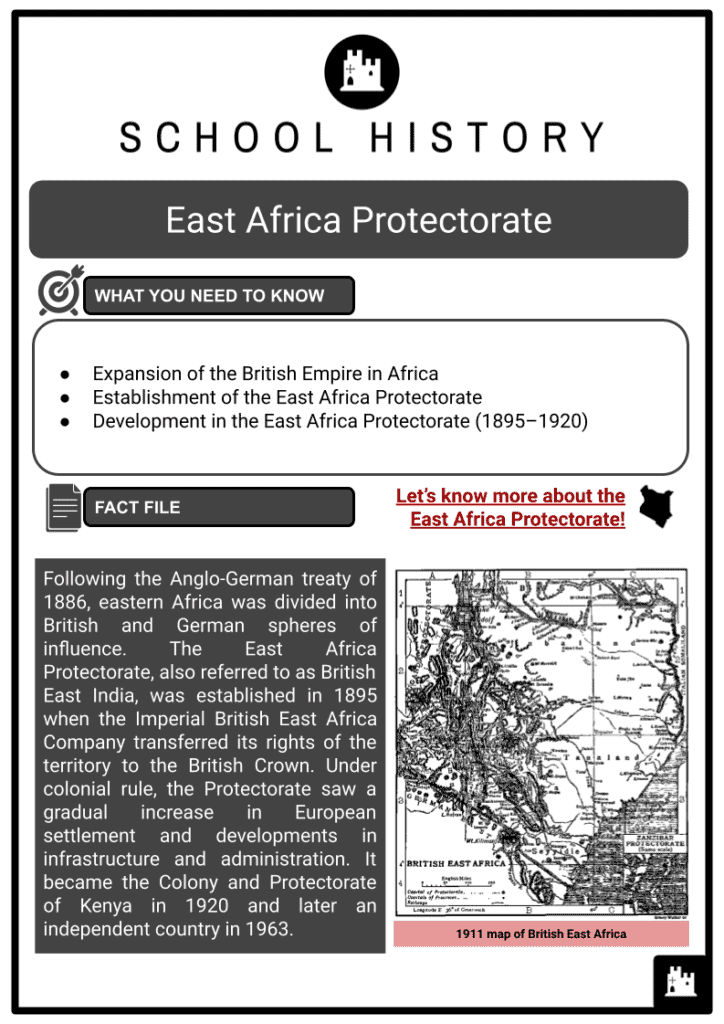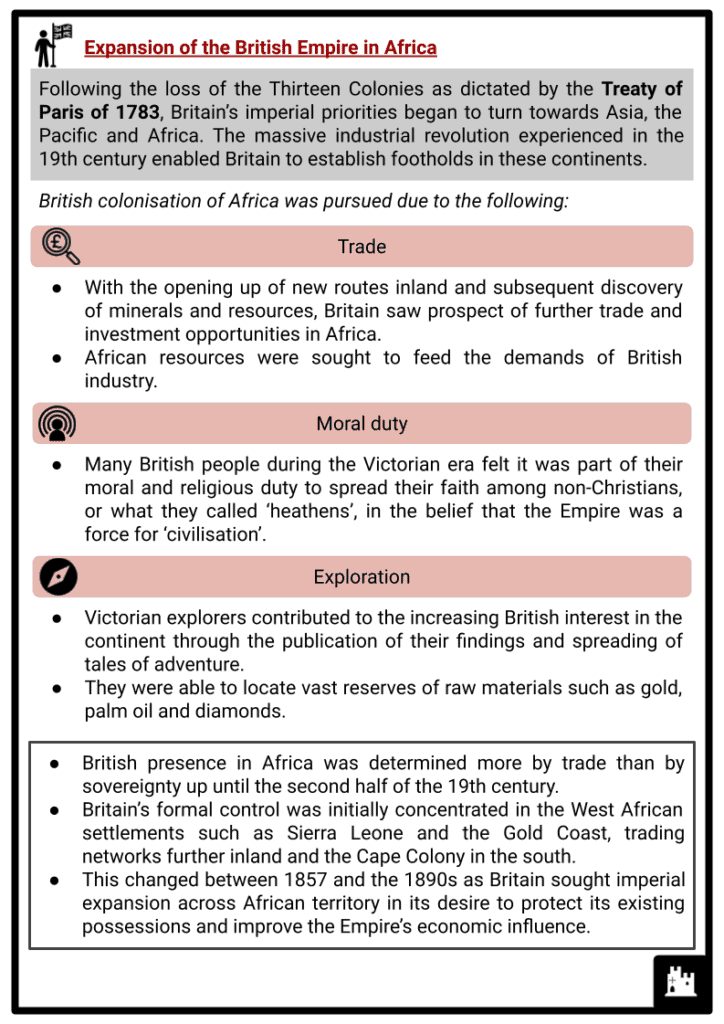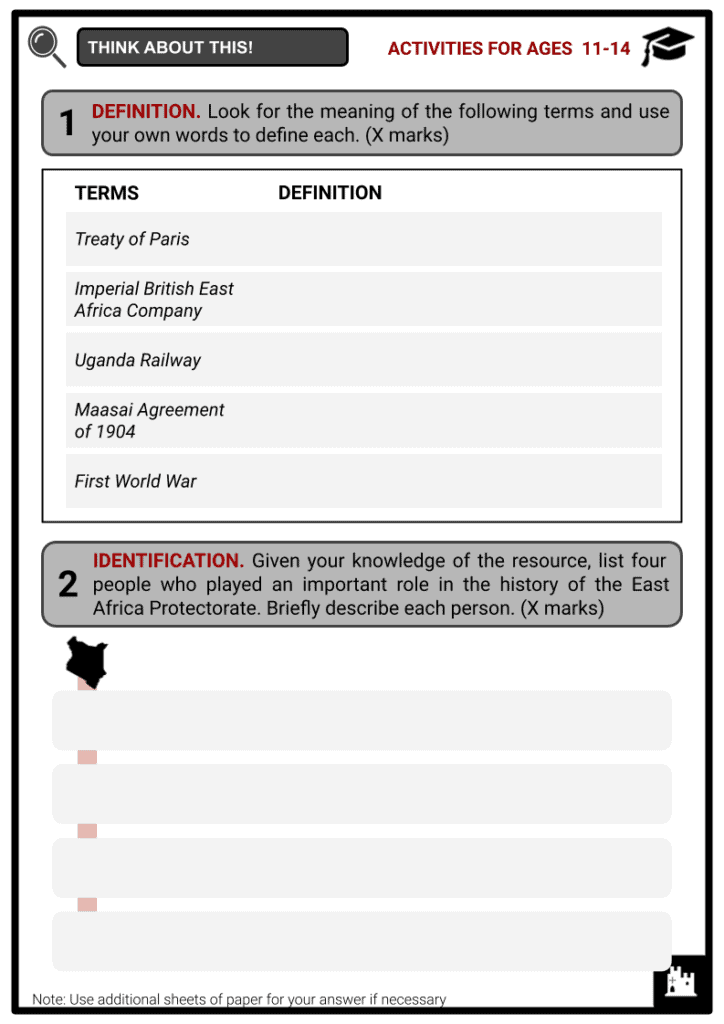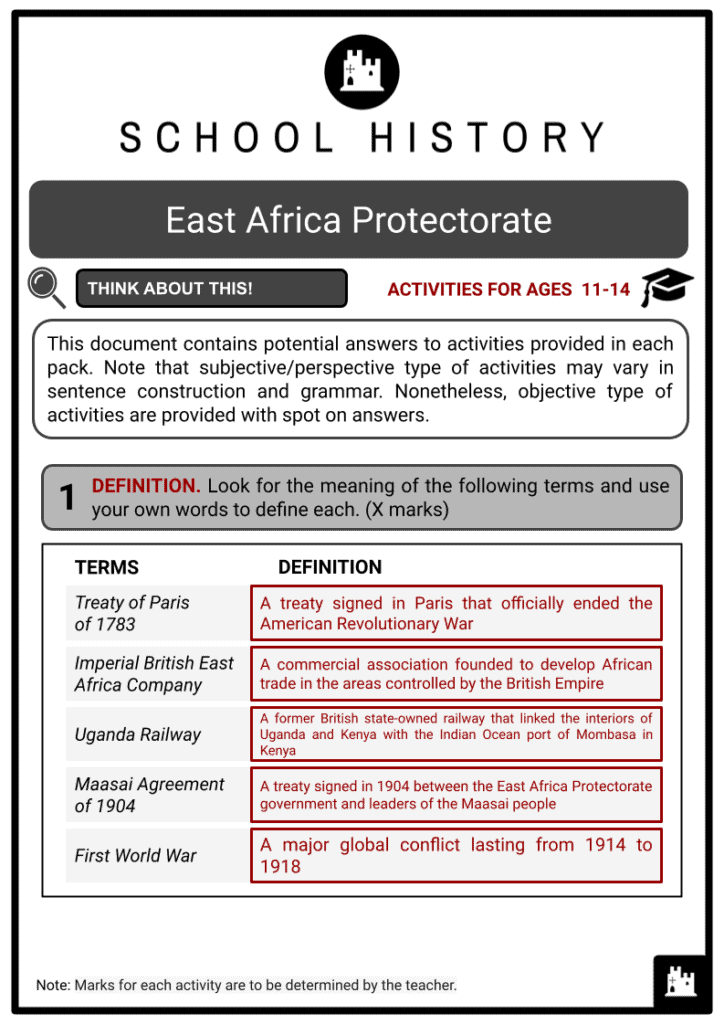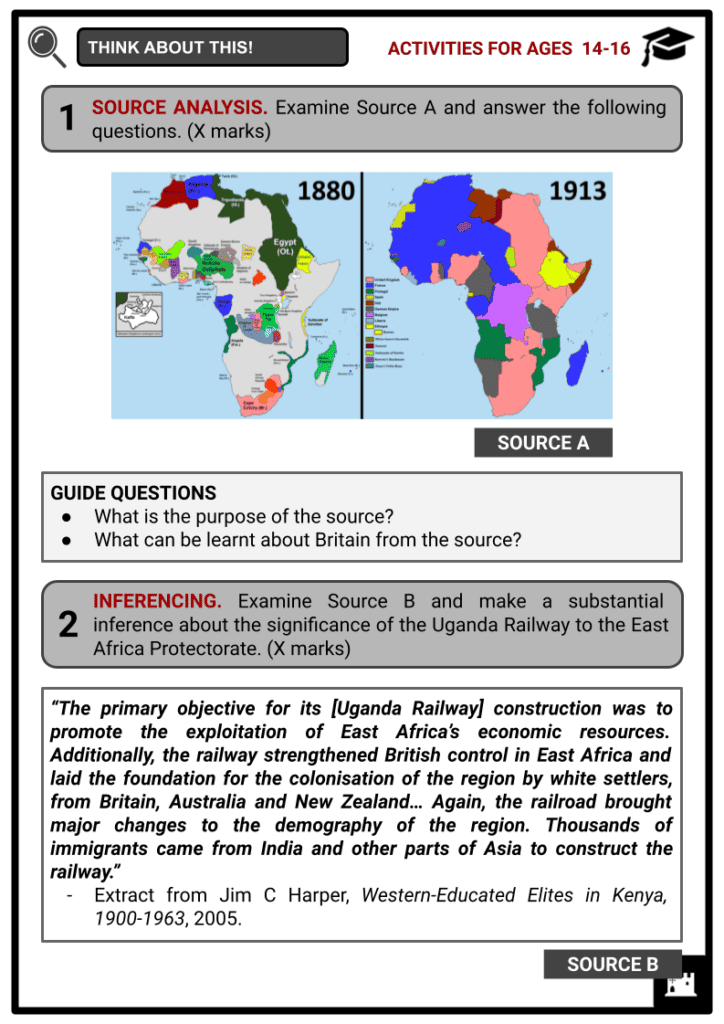East Africa Protectorate Worksheets
Do you want to save dozens of hours in time? Get your evenings and weekends back? Be able to teach about East Africa Protectorate to your students?
Our worksheet bundle includes a fact file and printable worksheets and student activities. Perfect for both the classroom and homeschooling!
Summary
- Expansion of the British Empire in Africa
- Establishment of the East Africa Protectorate
- Development in the East Africa Protectorate (1895–1920)
Key Facts And Information
Let’s know more about the East Africa Protectorate!

Following the Anglo-German treaty of 1886, eastern Africa was divided into British and German spheres of influence. The East Africa Protectorate, also referred to as British East India, was established in 1895 when the Imperial British East Africa Company transferred its rights of the territory to the British Crown. Under colonial rule, the Protectorate saw a gradual increase in European settlement and developments in infrastructure and administration. It became the Colony and Protectorate of Kenya in 1920 and later an independent country in 1963.
Expansion of the British Empire in Africa
- Following the loss of the Thirteen Colonies as dictated by the Treaty of Paris of 1783, Britain’s imperial priorities began to turn towards Asia, the Pacific and Africa. The massive industrial revolution experienced in the 19th century enabled Britain to establish footholds in these continents.
- British colonisation of Africa was pursued due to the following:
- Trade
- With the opening up of new routes inland and subsequent discovery of minerals and resources, Britain saw prospect of further trade and investment opportunities in Africa.
- African resources were sought to feed the demands of British industry.
- Moral duty
- Many British people during the Victorian era felt it was part of their moral and religious duty to spread their faith among non-Christians, or what they called ‘heathens’, in the belief that the Empire was a force for ‘civilisation’.
- Exploration
- Victorian explorers contributed to the increasing British interest in the continent through the publication of their findings and spreading of tales of adventure.
- They were able to locate vast reserves of raw materials such as gold, palm oil and diamonds.
- Trade
- British presence in Africa was determined more by trade than by sovereignty up until the second half of the 19th century.
- Britain’s formal control was initially concentrated in the West African settlements such as Sierra Leone and the Gold Coast, trading networks further inland and the Cape Colony in the south.
- This changed between 1857 and the 1890s as Britain sought imperial expansion across African territory in its desire to protect its existing possessions and improve the Empire’s economic influence.
British Expansion in Africa (1857–1890)
- Britain found a particular rival in France, which led to the formalisation of control of the former in areas where British traders had been operating. This was done by chartering companies including the Royal Niger Company, the Imperial British East Africa Company (IBEAC) and the British South Africa Company to enforce British claims in the continent.
Establishment of the East Africa Protectorate
- In the latter part of the 19th century, Britain and Germany raced to acquire unclaimed territories within areas of interest in Africa, which included the Sultanate of Zanzibar and the interior of eastern Africa. This common interest was resolved peacefully with an Anglo-German treaty signed in 1886, hence eastern Africa was divided into British and German spheres of influence. Germany laid claim to the coast of present-day Tanzania and Britain held access to present-day Kenya and Uganda.
- Meanwhile, Britain had other interests including the land obtained in southern Africa, leaving the government hesitant to take full control and administration of the newly acquired territory in eastern Africa.
- In an attempt to ease this burden, the British government urged the British ship-owner and businessman Sir William Mackinnon to take the responsibility of developing British influence and administering the eastern territory.
- Mackinnon owned a shipping company that traded extensively in the African Great Lakes and previously had an agreement with the Sultan in the region. He founded the IBEAC in 1888 and became its chairman.
- Authorised by the government with political and economic power over the region, the IBEAC was committed to abolishing the transatlantic slave trade, forbidding trade monopoly and promoting equal treatment for all nations.
- The company controlled an area of about 639,000 km2 (246,800 mi2) along the eastern coast of Africa with Mombasa as the administrative centre.

Map of British East Africa - The company was tasked with overseeing the exportation and management of goods and agriculture in the territory, but its chief role was to begin facilitating the construction of a railway linking the east coast region of Mombasa to Lake Victoria. However, funds were insufficient to begin the construction at the time.
- In 1890, the building of the Mackinnon-Sclater road, a 970-km (600-mi) ox cart track from Mombasa to Busia on the Uganda border, began.
- Furthermore, brewing conflict between rival factions in the region forestalled the IBEAC’s ventures.
- By 1893, the company began to fail, leading the rights of the territory under its control to be transferred to the British Crown. The territory was then divided to form the Uganda Protectorate on 18 June 1894 and the East Africa Protectorate on 1 July 1895 with the administration being transferred to the British Foreign Office.
Development in the East Africa Protectorate (1895–1920)
- With the beginning of colonial rule in the East Africa Protectorate, the fertile highlands became the site of European migration and conflict in the territory. In 1895, Sir Arthur Henry Hardinge was appointed as Colonial Head and was responsible for managing the construction of the Uganda Railway, which was key to development of the interior of the East Africa Protectorate. The railway project was resisted by some ethnic groups but eventually proceeded.
- The construction of the first piece of the Uganda Railway, a railway from Mombasa to Port Florence (Kisumu) on Lake Victoria, started in 1895. As part of this project, Nairobi and Port Florence were founded by colonial authorities in 1899 and 1901. This line was completed in 1901.
- The pioneer of European settlement Lord Delamere arrived in the highlands in 1897 and was amazed by the agricultural potential of the area.
- In 1902, the boundaries of the Protectorate were broadened to include what was formerly the Eastern Province of Uganda. In the same year, the East Africa Syndicate was granted with 1,300 km2 (500 mi2) to encourage white settlement in the highlands, an area long used by certain sections of the Maasai people. Extensive farming operations started in the area. This was further followed by several applications for land by Europeans, and Boers from South Africa.
- In 1904, the newly appointed Commissioner of Protectorate Sir Donald William Stewart and leaders of the Maasai people signed the Maasai Agreement of 1904. Under the agreement, the Maasai people would vacate the entirety of the Rift Valley so that the government could use it for European settlement, in exchange for exclusive rights to two territories, a southern reserve in Kajiado and a northern reserve in Laikipia.
- In 1905, numerous settlers arrived from England and South Africa and so the administration of the Protectorate was transferred from the Foreign Office to the Colonial Office. The capital was also transferred from Mombasa to Nairobi.
- In 1906, the office of Commissioner was replaced with the office of Governor. Lieutenant-Colonel Sir James Hayes Sadler became the first governor of the Protectorate. The Legislature was constituted. In 1907, the Government House in Nairobi was built to serve as the official residence of the Governor.
- In 1909, Sir Percy Girouard was appointed to the governorship of the Protectorate owing to his experience as High Commissioner in Northern Nigeria and his reputation as a railway administrator. At the time, the Protectorate was burdened by the huge capital costs of the Uganda Railway.
- Girouard believed that increased European settlement in the Protectorate was the only solution to this problem. He also sought to develop African traditional institutions towards some form of indirect rule and to remove dispensable officials. His actions won significant support from the British settlers.

Girouard (left) in 1909 - In 1911, Girouard persuaded certain leaders of the Maasai to agree to move from Laikipia to a greatly enlarged southern section incorporating the Loita Plains. This was met with opposition from missionaries as well as humanitarian lobbies in Britain, leading to a dispute between Girouard and the Colonial Secretary. Girouard resigned his post in 1912.
- In 1914, there were approximately between 3 and 4 million Africans, over 12,000 Asians and 3,500 Europeans in the Protectorate.
- During the First World War (1914–1918), the Protectorate became a military base for the British. When the war broke out, the governors of the Protectorate and the German East Africa initially agreed on a truce in an effort to keep the territories out of direct hostilities. The truce was broken off when the German military commander Paul von Lettow-Vorbeck conducted an effective guerrilla warfare campaign in East Africa.
- When the armistice was signed in 1918, Lettow-Vorbeck retreated to Portuguese East Africa and finally surrendered in Northern Rhodesia. After the conflict, the German East Africa was ceded to Britain and Belgium. More farmers arrived in the Protectorate from England and South Africa after the First World War.
- By 1919, the European population in the Protectorate was estimated at 9,000 settlers. The settlers began lobbying to transform the Protectorate into a British Crown colony. This was achieved on 23 July 1920 when the Colony and Protectorate of Kenya was established. This meant more powers given for the settlers as more of them could be elected to the Legislative Council.
- On 12 December 1963, the Colony and Protectorate of Kenya came to an end when Kenya became an independent country under the Kenya Independence Act 1963, which founded the independent Commonwealth realm of Kenya, with Queen Elizabeth II as head of state. Exactly a year after its independence, Kenya became a republic under the name Republic of Kenya.
Image Sources
- https://upload.wikimedia.org/wikipedia/commons/4/46/Britisheastafrica_1.png
- https://upload.wikimedia.org/wikipedia/commons/thumb/3/3e/Africa_1909_16a.png/250px-Africa_1909_16a.png
- https://upload.wikimedia.org/wikipedia/commons/thumb/4/41/Sir_Percy_Girouard%2C_Kenya_1909.png/800px-Sir_Percy_Girouard%2C_Kenya_1909.png
Frequently Asked Questions
- What was the British East Africa Protectorate?
The British East Africa Protectorate was a colonial territory established by the British Empire in East Africa during the late 19th and early 20th centuries. It encompassed present-day Kenya, parts of Uganda, and South Sudan.
- When was the British East Africa Protectorate established?
The protectorate was established in 1895, initially focusing on the coastal region of present-day Kenya. It expanded over time to include larger inland areas.
- What were the reasons for establishing the protectorate?
The British established the protectorate to secure their interests in the region, including control over trade routes, resources, and influence from other European powers in the face of competition.

